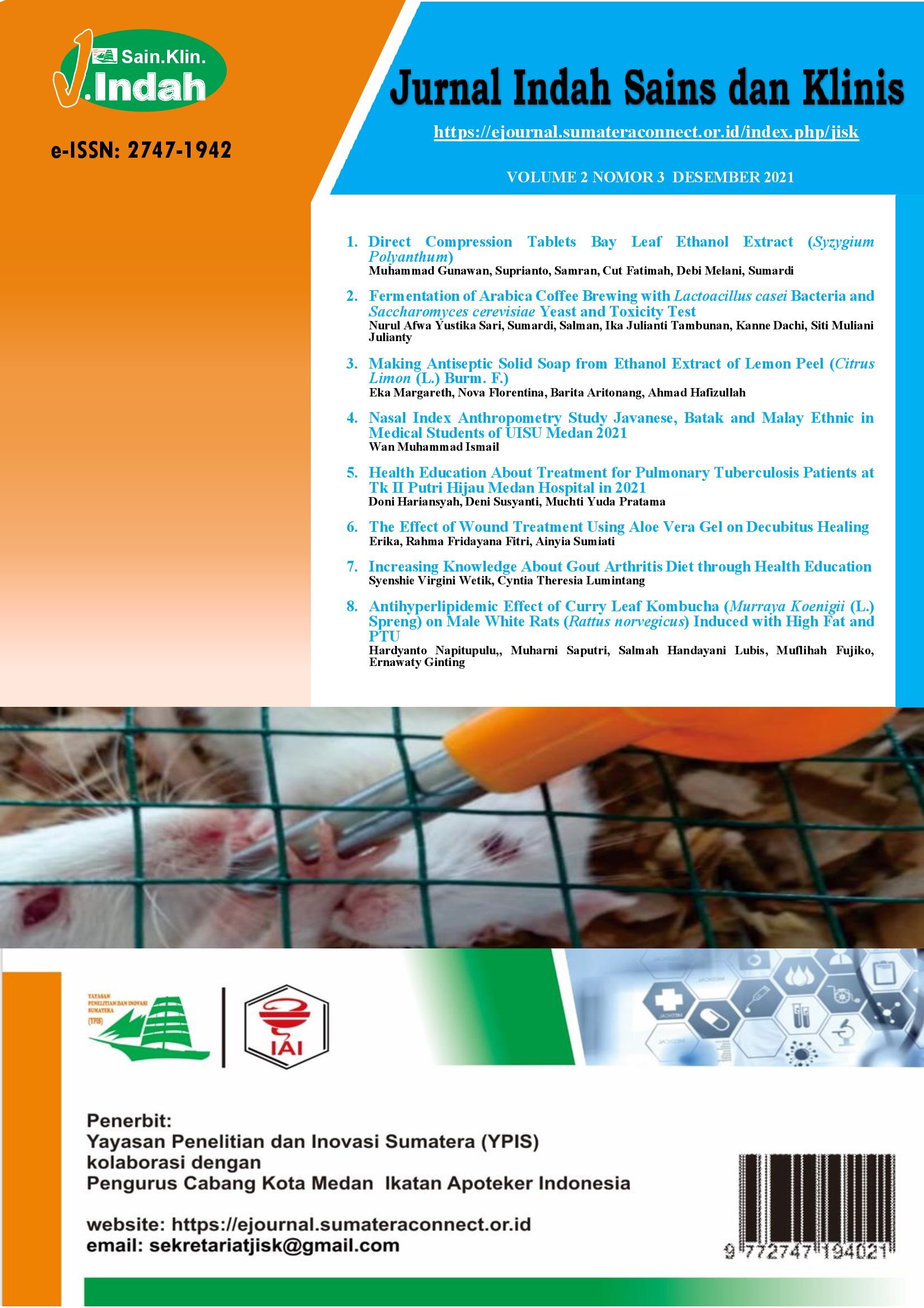Fermentation of Arabica Coffee Brewing with Lactoacillus Casei Bacteria and Saccharomyces Cerevisiae Yeast and Toxicity Test
DOI:
https://doi.org/10.52622/jisk.v2i3.32Keywords:
Fermentation, Arabika coffee, Lactobacillus casei, Saccharomyces cerevisiae, brine shrimp lethality testAbstract
Coffee drinks are one of the most popular drinks for people of all ages, especially adults. But now with the addition of flavor, most people are enjoying coffee drinks.The purpose of the study was to see the effect of fermentation on the taste and aroma of brewed Arabica coffee with Lactobacillus casei and yeast Saccharomyces cerevisiae isolates with the addition of grape juice and sucrose and the level of toxicity of the fermentation of brewed Arabica coffee with the Brine Shrimp Lethality Test (BSLT).This research is experimental, namely the fermentation of brewed Arabica coffee with Lactobacillus casei and yeast Saccharomyces cerevisiae isolates with the addition of grape juice and sucrose. Fermentation was carried out for 3 days at open room temperature under anaerobic conditions. The results of the fermentation were tested for Brine Shrimp Lethality Test (BSLT), alcohol content test and organoleptic test by 15 panelists. Furthermore, the data were tested using the hedonic test of analysis of variance.The results of the variance showed that the fermentation of roasted Arabica coffee and green beans on taste obtained F count < F table 1% showed no significant difference, for aroma obtained F count > F table 1% showed there was a significant difference, to the color of the steeped fermented sample Roasted Arabica coffee obtained F count < F table 1% shows there is no real difference while in green beans obtained F count > F table 1% shows there is a significant difference.
Downloads
References
Ramadhani, dkk. Pola Perubahan Dimensi Biji Kopi Arabika (Coffea arabica) Selama Proses Pengeringan. Jurnal Argritechno. 2019;12(1):4-7. http://agritech.unhas.ac.id/ojs/index.php/at/article/view/194
Sinaga, A. Fermentasi Kopi Arabika Lintong Nihuta : Pengaruh Variasi Jenis Wadah dan Lama Waktu Fermentasi terhadap Mutu Kopi. Skripsi. Medan : Fakultas Teknik Universitas Sumatera Utara. 2018.4-5 https://repositori.usu.ac.id/handle/123456789/9415
Kusdiyantini dkk. Fermentasi Kopi Robusta (Coffea canephora) Menggunakan Isolat Bakteri Asam Laktat dari Feses Luwak dengan Perlakuan Lama Waktu Inkubasi. Jurnal Biologi. 2015 https://ejournal3.undip.ac.id/index.php/biologi/article/view/19417
Muti’ah dkk. Uji Fitokimia dan Uji Toksisitas Ekstrak Etanol Tanaman Kesembukan (Paederia foetida L.) dengan Metode Brine Shrimp Lethality Test. Alchemy. Malang : UIN Malik Ibrahim. 2014 http://ejournal.uin-malang.ac.id/index.php/Kimia/article/viewFile/2918/4840
Fajriyanti A. R. Penelusuran dan Isolasi Fungi Tanah Muara Sungai Desa Kilensari Kecamatan Panarukan Serta Skrinning Aktivitas Antibakteri Terhadap Pseudomonas aeruginosa. Skripsi. Jember : Universitas Jember. 2020 https://jurnal.uns.ac.id/jpscr/article/view/44007
Limbong dkk. Uji Toksisitas Ekstrak Etanol Daun Belimbing Wuluh (Averrhoa bilimbi L.). Journal of Pharmaceutical and Medicine Science. Makassar : Sekolah Tinggi Ilmu Farmasi Makassar.2019 https://www.jpms-stifa.com
Alfabasyi, M. A. M. Rancang Bangun Alat Identifikasi Kadar Alkohol pada Minuman Berbasis Mikrokontroler AVR ATMEGA 16. Skripsi. Malang : Universitas Islam Negeri. 2013 http://etheses.uin-malang.ac.id/7457/1/06550128.pdf
Pereira, G. Potential of Lactic Acid Bacteria to Improve The Fermentation and Quality of Coffee During on Farm-Processing. Jurnal of Food Science and Technology. Taylor and Francis Grup. 2016 https://ifst.onlinelibrary.wiley.com/doi/abs/10.1111/ijfs.13142
Rarasati, dkk. Karakteristik Organoleptik dan Fisikokimia Kopi Jahe Celup pada Variasi Tingkat Penyangraian dan Kosentrasi Bubuk Jahe. Jurnal Agroteknologi. Jember : Universitas Jember. 2019 https://jurnal.unej.ac.id/index.php/JAGT/article/view/8370
Evangelista et al. Inoculation of Staeter Cultures in A Semi-Dry Coffee (Coffea arabica) Fermentation Process. Brazil : Federal University of Lavras. 2014
https://www.sciencedirect.com/science/article/pii/S0740002014001191
Grace, dkk. Karakteristik Sensori, Kandungan Kafein dan Asam Klorogenat Kopi Bubuk Robusta (Coffea canephora L.) di Tanggamus, Lampung. Seminar Nasional Perhimpunan Ahli Pangan Indonesia. Lampung : Universitas Lampung. 2017 http://repository.lppm.unila.ac.id/7261/1/Setyani1.pdf
Wiranata dkk. Pengaruh Fermentasi Menggunakan Bakteri Asam Laktat Yoghurt Terhadap Citarasa Kopi Robusta (Coffea Robusta). Jurnal Agriteknologi. Makassar : Universitas Hasanuddin. 2019 http://agritech.unhas.ac.id/ojs/index.php/canrea/article/view/26
Ardiyanti, Y dan Marsah, R. U. (2019). Analisis Aktivitas Toksisitas Beberapa Minyak Atsiri dengan Metode Brine Shrimp Lethality Test. Journal of Holistic and Health Science. Karawang : Universitas Singaperbangsa Karawang. http://jhhs.stikesholistic.ac.id/index.php/jhhs/article/view
Downloads
Published
Issue
Section
License
Copyright (c) 2024 Jurnal Indah Sains dan Klinis

This work is licensed under a Creative Commons Attribution-NonCommercial-ShareAlike 4.0 International License.









 This work is licensed under a
This work is licensed under a 
